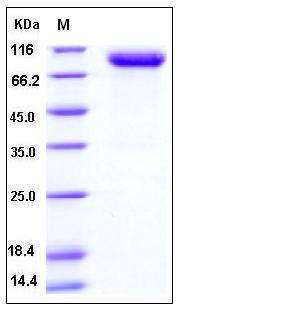Mouse PLAUR / CD87 / uPAR Protein (His & Fc Tag)
Cd87,u-PAR,uPAR
- 100ug (NPP3448) Please inquiry
| Catalog Number | P50160-M03H |
|---|---|
| Organism Species | Mouse |
| Host | Human Cells |
| Synonyms | Cd87,u-PAR,uPAR |
| Molecular Weight | The recombinant mouse PLAUR/Fc is a disulfide-linked homodimer after removal of the signal peptide. The reduced monomer consists of 522 amino acids and has a predicted molecular mass of 58 kDa. In SDS-PAGE under reducing conditions, the apparent molecular mass of rmPLAUR/Fc monomer is approximately 80-90 kDa due to glycosylation. |
| predicted N | Leu 24 |
| SDS-PAGE |  |
| Purity | > 97 % as determined by SDS-PAGE |
| Protein Construction | A DNA sequence encoding the extracellular domain (Met 1-Thr 297) of mouse PLAUR (NP_035243.1) precursor was fused with the C-terminal polyhistidine-tagged Fc region of human IgG1 at the C-terminus. |
| Bio-activity | Measured by its binding ability in a functional ELISA . Immobilized human uPA at 5 μg/ml (100 μl/well) can bind mouse PLAUR with a linear ranger of 1.6-40 ng/ml . |
| Research Area | Immunology |Innate Immunity |Coagulation |
| Formulation | Lyophilized from sterile PBS, pH 7.4 1. Normally 5 % - 8 % trehalose, mannitol and 0.01% Tween80 are added as protectants before lyophilization. Specific concentrations are included in the hardcopy of COA. |
| Background | Urokinase plasminogen activator (uPA) and/or its receptor (uPAR) are essential for metastasis, and overexpression of these molecules is strongly correlated with poor prognosis in a variety of malignant tumours. uPAR and uPA levels in both resected tumor tissue and plasma are of independent prognostic significance for patient survival in several types of human cancer. This system has classically been thought to drive tumor progression by mediating directed extracellular proteolysis on the surface of migrating or invading cells, and intervening with this proteolysis by targeting uPAR has been proposed to represent a novel approach for inhibiting tumor progression. uPAR, also known as PLAUR or CD87, has been implicated in the growth, metastasis, and angiogenesis of several solid and hemotologic malignancies. uPAR is a highly glycosylated, 55-60kDa integral membrane protein linked to the plasma membrane by a glycosylphosphatidylinositol (GPI) anchor. It is part of a cell surface system that also consists of the serine protease uPA and several specific inhibitors (plasminogen activator inhibitors 1 and 2). Additionally, the analysis of CD87 (urokinase-type plasminogen activator receptor - uPAR) expression has a potential role in the diagnostic or prognostic work-up of several hematological malignancies, particularly acute leukemia and multiple myeloma. |
| Reference |
